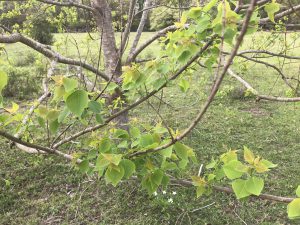Chinese Tallow, also known as the Popcorn Tree, was introduced in the US over 200 years ago. Ben Franklin sent seeds over in 1772. Although Franklin was blamed for the invasion in the U.S. Gulf Coast, scientists performed genetic testing and have concluded that the blame actually lies with federal biologists who imported some Chinese tallow trees around 1905. Popcorn trees have continued to spread throughout the US since then.
For many years, people have planted them in their landscape for shade and fall color. Once established, they invade natural areas, pastures, wetlands and yards. They out-compete native and non-invasive trees and shrubs. In 1998, Chinese Tallow was added to the Florida Department of Agriculture and Consumer Services Noxious Weed list. Plants on the Florida Noxious Weed list may not be introduced, possessed, moved, or released without a permit.
Landowners and homeowners can help with this problem tree by removing and replacing them with a native or non-invasive tree like black gum, maple, dogwood, or crepe myrtle. Mature trees can be cut down with a saw and the stump promptly treated with an herbicide with the active ingredient, triclopyr amine. You should try to make the final cut as low to the ground as possible. You can use a paint brush to apply the herbicide to the stump. A basal bark application of triclopyr ester plus a basal oil carrier can be used on smaller trees. Treat the trunk to a height of 12 to 15 inches from the ground, thoroughly wetting it with the herbicide mixture. Basal bark treatments are only effective on saplings and seedlings less than 6 inches in stem diameter. Sometimes suckers may sprout from remaining roots. A foliar application can be used on these sprouts from July to October, before onset of fall color.
For more information about Chinese Tallow trees or other invasive weeds, go to: https://edis.ifas.ufl.edu/ag148.
- Have a Safe and Legal Hunting Season - November 10, 2025
- Killer Turkey Food Plot - January 31, 2025
- Common Wildlife Food Plot Mistakes - November 8, 2024

